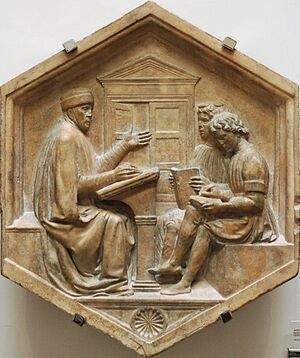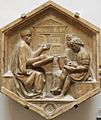Priscian facts for kids
Priscianus Caesariensis, often called Priscian, was a famous Latin grammarian who lived around 500 AD. He wrote a very important book called Institutes of Grammar. This book became the main textbook for studying Latin during the Middle Ages. It also helped create the field of speculative grammar, which looked at the deeper rules of language.
Contents
Who Was Priscian?
Not much is known about Priscian's personal life. He was born and grew up in Caesarea, a city in North Africa (which is now Cherchell, Algeria). At that time, this area was controlled by the Vandalic Kingdom. Priscian was likely of Greek background.
According to a writer named Cassiodorus, Priscian taught Latin in Constantinople in the early 500s. He wrote a special poem for the Roman Emperor Anastasius I, who ruled from 491 to 518. This poem, written around 512, helps us know when Priscian lived. Also, copies of his main work show that it was copied by a clerk in the imperial office in 526 and 527.
Priscian's Important Works
Priscian's most famous book is the Institutes of Grammar (in Latin, Institutiones Grammaticae). This book explains Latin grammar in a very detailed way. It has eighteen parts, called books. The first sixteen books mainly discuss sounds, how words are formed, and how they change (like verb endings). The last two books, which are a big part of the whole work, focus on syntax. Syntax is about how words are put together to make sentences.
Priscian's grammar was based on earlier works by other scholars like Herodian and Apollonius. A great thing about his book is that it includes many examples from old Latin writers. These examples have helped save parts of works by authors like Ennius, Pacuvius, and Lucilius that would otherwise be lost. He often quoted famous writers such as Virgil, Terence, Cicero, and Plautus.
His grammar book was very popular and used by many scholars in the 8th and 9th centuries, including Aldhelm, Bede, and Alcuin in Britain. There are about a thousand copies of his book still existing today. Most copies only have books 1 to 16, and these are sometimes called the Priscianus Major ("Greater Priscian"). Other copies only have books 17 and 18, known as his work On Construction (De Constructione) or the Priscianus Minor ("Lesser Priscian"). Some rare copies have both parts. The oldest copies we have are from the 9th century.
Other Writings by Priscian
Priscian also wrote several smaller works:
- Three books for a man named Symmachus. These included topics like weights and measures, the rhythms of Terence's plays, and a Latin translation of Greek writing exercises.
- De nomine, pronomine, et verbo ("On noun, pronoun, and verb"). This was a shorter version of parts of his main grammar book, made for teaching in schools.
- Partitiones xii. versuum Aeneidos principalium. This was another teaching tool. It used questions and answers to break down the first lines of each of the twelve books of Virgil's Aeneid. It looked at the rhythm, scanned each line, and carefully explained every word.
- The poem for Emperor Anastasius, which was 312 lines long.
- A translation of a geography book written in verse by Dionysius Periegetes.
Priscian's Lasting Impact
The last two books of Priscian's Institutes, especially his work On Construction, were very important. They were a key part of the subjects taught at the University of Paris in the 13th century. The lectures given by Roger Bacon on these books likely led to his own book, Overview of Grammar. This was one of the first times someone explored the idea of a universal grammar, which suggests that all human languages share some basic rules.
Images for kids
See also
 In Spanish: Prisciano para niños
In Spanish: Prisciano para niños





